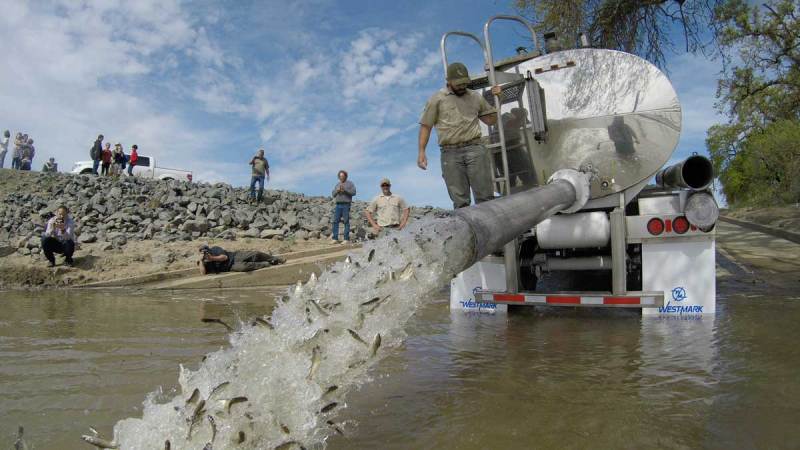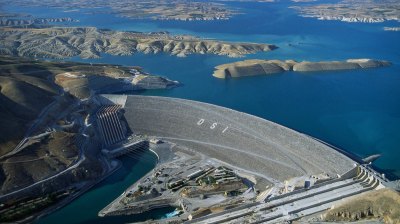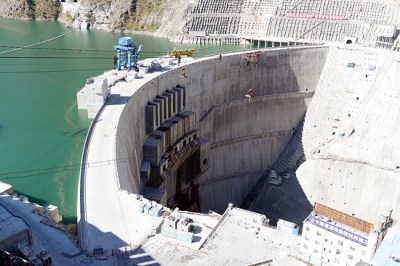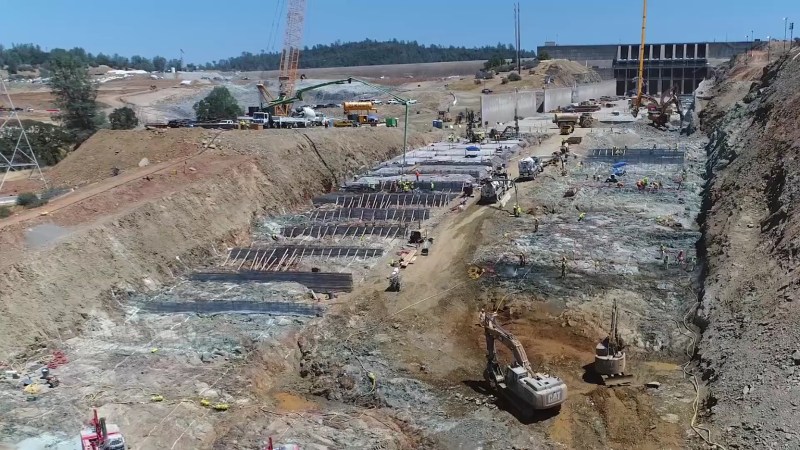More than two years ago, the largest dam in the United States experienced a catastrophic failure of its main spillway, the primary means by which operators of the dam prevent the lake from cresting its pen. The spillway failure caused so much erosion that the hydroelectric plant could not operate, further worsening the situation. In a few days, the dam was finally put to its design limitations, and water began flowing down an emergency spillway that had never been used, prompting the evacuation of 188,000 people living in downstream communities.
Since the time that this crisis came to a head, crews have been working around the clock to repair the main and emergency spillways in order to ensure that one of the largest pieces of infrastructure in the wealthiest country in the world does not suffer a complete failure. The dam’s spillways were reopened recently on April 2, in time for this year’s snow melting, and so far everything looks good.
The repair work was a true feat of engineering, and perhaps a logistics miracle as well. The video below goes over a lot of the raw materials inputs that were needed, but the one that stuck out the most was that a dump truck full of roller-compacted concrete was emptied every five minutes over the entire course of the repair — enough to build a sidewalk from the Oroville Dam to Texas. Part of the reason for the use of such an incredible amount of concrete was that it wasn’t just used to repair the main spillway. An enormous “splash pad” for the emergency spillway was also constructed to limit erosion in the event that it must be used again. But the full change goes beyond concrete and rebar. Join me after the break as I try to wrap my mind around the full scope of the Oroville Dam repair.
Won’t Somebody Think of the Fish? (Actually, They Did)

The other, perhaps more obvious, issue that the sediment in the lower basin was preventing the power station from running at all. Since the generators are situated at the base of the dam, the blockage that was caused by the extreme erosion prevented any outflow from this part of the dam. Before restoring the ability of the generators to run (and lower the lake level some as a side effect), all of the debris had to be removed before the real work of repairing the main spillway could be finished.
Once repairs were complete, dam operators tested out the main spillway with a small flow, and planned to increase the flow to a level greater than that let out of the lake when the spillway first experienced problems two years ago. So far there have been no reported problems with the repaired spillway and the dam is operating as intended.
On the List of Largest Engineering Projects

Concrete arch dams require a narrow valley of strong rock to build an effective structure, and gravity dams require a solid rock foundation in order to prevent the structure from sinking. Embankment dams, like Oroville, do not have these same requirements and can be built in areas with less strict requirements, although the downside is the enormous amount of material needed to construct them. This was part of the failure mode of the Oroville Dam’s emergency spillway, situated on the back side of the embankment. Since it was constructed of earth and not concrete, it was able to erode away rapidly which threatened the structural integrity of the dam.
Of course, arch and gravity dams are not immune to issues either. Spillways at the Hoover Dam suffered damage from cavitation in each of the two instances they were needed. At the Grand Coulee Dam, damage to the spillways occurred during a year with heavy rainfall when the spillways were used in a greater capacity than they had been in the past. Typically, though, these issues do not result in the type of damage seen at Oroville, and can even be prevented by draining the reservoir further down earlier in the season (although this is dependent on accurate weather forecasting).
A Dam Renaissance

While there are taller dams, dams which impound more water, larger dams, or dams which generate more electricity, with proper maintenance these dams will all hopefully be able to avoid any kind of Oroville-like issues in the future.
The Blame Game
Unfortunately, repairing the problems at Oroville is unlikely to be the end of the story. The current issue is deciding which level of government is going to pay for the $1 billion repairs. The federal government claims that this repair does not qualify for federal funds, since the failure of the dam was a result of poor management and maintenance practices. That means California is likely on the hook for the bill, and won’t be able to come up with the money easily.
Regardless of how the financial and political situation plays out, the crisis at the Oroville Dam can be viewed as an example of what is likely to happen to a majority of the rest of the bridges, dams, canals, and other critical infrastructure as maintenance budgets continue to stretch. Unfortunately, beating this dead horse has yet to result in any measurable change in policy, even after almost 200,000 lives were put at risk as a result of this specific incident alone.
Even if the piece of infrastructure is small, it isn’t immune from lack of maintenance. Even a small bridge on U.S. Highway 1 in Florida that experienced a critical structural failure late in 2017 still hasn’t been fixed yet, likely due to government squabbles, lack of funding, or both.
Perhaps the next time we cross a bridge, fly on an airplane, take a drink of water, or even turn on a light switch, we should consider the state of our infrastructure, from the large to the small. It might not all turn out as well as the Oroville Dam.
















It’s sexier to build new stuff than to maintain existing infrastructure, or so goes government thinking.
Yeah, there is not much sexy about maintenance, government or otherwise.
Or build High Speed rail to nowhere, right nearby a failing damn (so to speak). Priorities…This is why the rest of the country has very little sympathy for CA.
After you pay off the voting special interest groups that elect you with tax dollars there isn’t much left for infrastructure. I can guarantee there are records from engineers warning of needed maintenance for decades. Infrastructure doesn’t vote. When it fails politicians blame someone else and try to pawn off responsibility.
in minnesota the 35 bridge failed and people died in the fall – trying to make it liberal vs republican is part of the blame game to cut taxes and not pay for infrastructure. face it, voters want “free”. nothing is “free”. cutting taxes makes bridges fall, dams fail, roads go bad, power fluctuate, water polluted, air bad to breath, everybody wants to talk about government waste in construction – those saying such tripe have zero idea what it takes to work outside in the heat and cold day after day and build things. they sit at there computer and spout off how much cheaper it should all be. well its not, and its never going to be. all road, water, sewer, dam, airport, storm sewer, water control taxes will need to rise before more folks die from bad decisions. almost none of the recent failures were not known risks – but voters and polititians just don’t want to deal with it till its “real expensive” bummer huh?
But more importantly who’s cutting taxes?
Not California.
IMO that depends on the government involved. Even many private entities decide to demolish, rather than rebuild, restore, or update.
And the U.S.A. is not the wealthiest country in the world. Why do you always think that?
It’s a mystery…
https://en.wikipedia.org/wiki/List_of_countries_by_total_wealth
Yet also the largest national debt of any nation in the world, by far. This word “wealth”…
https://en.wikipedia.org/wiki/Government_debt
America first! America first! America first! :-D
Not all debt is a bad thing. I used to think so, but after taking classes on finance I started to learn more. Obviously too much debt and ‘bad’ debt can lead to issues, but in the world of modern finance, debt can be a powerful tool that can help you drive higher probability and net more money than if you had not taken on the debt. Also, in your list USA is 13th when sorted by % of GDP which is by far more important than just the amount. Also also, the USA is one of the most transparent countries about debt (hence the asterisk explaining how the USA number accounts so accurately) while countries like China have had whistle blowers show that they are orders of magnitude lying about their finances. As an American, I wish we had less debt, especially when it comes to lining the pockets of the Military Industrial Complex, but we are still the best!
“but after taking classes on finance”
lol so the brainwashing was a success.
congratulations
https://en.wikipedia.org/wiki/List_of_countries_by_wealth_per_adult
Here it is :)
Fiddle the statistics long enough and you can get them to show whatever you like.
Take a look at “mean wealth per adult” or even worse “median wealth per adult” and the USA is nowhere near the wealthiest.
~ 55,000ft of drainage pipe, which stacked vertically would be more than 10 miles high. ~ What the actual #*@$? I wonder how long it would be if laid end to end horizontally?! Bonus: 10 miles high is more than 3,000 giraffes…
I only understand Eiffel Towers as a unit of height, and distances as areas of Wales per Watt hour x how hard I have to pedal.
I generally use the metric unit of ‘American football fields long’ for distance. For short distances I prefer school busses parked and to end.
Yeah, but how many Libraries of Congress full of water?
I don’t think you could stack that pipe 10 miles high without another catastrophic failure…
I have to convert it to km. 55*0,3 is about 16,5km – higher than most planes fly. Or about the distance from my apartment to where my parents live.
“That means California is likely on the hook for the bill,” any they should be. They get free power from the dam, and charge people for the energy. They should have a ton of money left from it when there is minimal cost because they dont buy any fossil fuels.
Generation is only part of the equation. Transmission and distribution are great costs, and there are maintenance costs, employees to pay…
It’s not free power…
It’s a profitable venture that has paid back its investment a long time ago, and nowadays it’s just making profit to the owners – who neglect to put any of that profit into maintenance.
If it’s not a profitable venture, then it should be dismantled because it costs more in taxpayer money than it returns in the value of energy – and you could buy the energy cheaper or make it otherwise.
And that whole thing is build because some people think that nuclear energy is bad and water power is ecology.
* and doesn’t harm the environment as much, either.
Its priorities go in this order: Flood control > Water storage > Power generation
No. Its original and main purpose was to create a water supply.
If the old egyptians had nucleair energy and were as clumsy as we are with it, we could not visit the pyramids for the next 20k years… The remains of a dam can be walked over or lived nearby actually as soon as the water has gone. Call that retard thinking…
Hover not in my back yard in regards to both the nuclear power plants, and nuclear waste disposal will always be in play. Also you use a pretty broad brush to criticize others.
Nuclear energy tend to be worse in term of consequence of lack of maintenance.
Even France which is the most nuclearized country in the world struggles with keeping maintenance standards.
Consequences for a catastrophic damp rupture: deads and rebuild (France, Malpasset, the only arc dam rupture: 500 immediate deaths). But afterward you just rebuild.
Consequences for a nuclear accident: way less deaths (most non immediate, so can be denied and minimized) but the loss of land is for *really* long time (Chernobyl, Fukushima). It also fuel the nuclear backslash for decades.
I was really excited when I saw the headline, and kind of let down after reading. The whole thing read could like a last minute ‘get some stats from Wikipedia’ report that could have been summed up as ‘the dam is big, one of the biggest in the world, and took a lot of material and work to fix’. I was hoping for more details on how they performed the repair. I’d guess that will $1bn spent there would be at least some interesting stories or technical problems they had to solve.
In the name is constructive criticism: the fish section was good, but felt a bit rushed. That was the only part that actually brought up how they repaired it.
If you like fish stories, look up Feather River Fish Hatchery adjacent to the Oroville Dam. When I grew up in the area the hatchery and how it operated was almost as interesting to me as the dam and power generation (which my grandfather worked on).
The hatchery was impacted by the spillway failure event.
https://vimeo.com/110311107
If you want the full rundown of this failure and repair, watch the full sequence of updates from this guy.
https://www.youtube.com/user/blancolirio/videos
He has some real insights into the 737 Max issues too. Spoiler – he is a professional commercial pilot, and knows what he is talking about.
I live in Yuba City downstream. His videos were the only non clickbait on YouTube.
Yes, as far as all things plane based. I’m not so sure about dams.
Most folks don’t know the emergency spillway came within 30 minutes of total failure. Had it failed, erosion would have cut a deep channel right next to the dam. One major city nearby would have been under well over 100 feet of water. Incredibly enough, most of those who fled the area drove in the same direction the water would have gone, rather than heading to higher ground.
“Incredibly enough, most of those who fled the area drove in the same direction the water would have gone, rather than heading to higher ground.”
this is california.
not incredible at all.
not even surprising…
Lots of California hate around here. WTF?
hey you know what, most roads also run in the same direction!
President Trump asked all the State Governors to have lists prepared of their most pressing infrastructure needs. California didn’t put the Oroville dam on their list, despite having known about its problems for a long time. The Sierra Club (usually an outfit trying to get dams removed) sued California in an attempt to get the state to do the repairs to the dam.
When built, Oroville’s primary purposes were water storage and flood control. That required maintaining the level at around 50% full most of the time. That reduced the amount of power that could be generated. Some time later the dam’s primary purpose was changed to power generation, which required maintaining a higher average water level.
When the exceptionally heavy snowfall happened, the people in charge of the dam refused to draw down the level to accommodate what would be record runoff from melting snow. Taking it down to 50% or lower would reduce the power output. Probably would’ve had to be taken down to 30% or maybe less to hold the runoff while running as much as possible through the turbines to avoid having to use the spillways.
I worked on this dam in 1966 thru 1967 as a field engineer for the general contractor building the head works structure, main spillway and overflow weir. Left California after finished contract work and moved back to California in 1998 (Pine Grove). Visited the dam site several times between 1998 and 2005 and saw lack of maintenance each time. I also spoke to the reservoir manager on some of those occasions about maintenance, repair to the tainer gates and seismic issues. He was very open that the “budget” for those items had been low priority for years (no specific number). He gave me a VIP tour because I proved to him I worked there during the final stages.
All that said, the California State Government and it’s California State Water Resources Control Board (SWRCB) are to blame for the entire issue at hand. I have followed this situation from beginning to now in great and grinding detail. The end is not near and the lawyers are circling. I have spent 37 years building dams all over the free world and this dam has been mismanaged for a long time.
As to President Trump’s role in this, I suggest that California look to ex-governor Moonbeam, ex-gonvernor Moonbeam’s father and The Clinton Foundation for help. Remember all they Clinton’s Foundation did for Haiti.
BY FAR the best coverage of the whole dam project can be found on the YouTube channel “blancolirio”
https://www.youtube.com/user/blancolirio/videos
$1B for repairs towards the measly 819MW power generation?
It seems like an overboard repair, when contractors go crazy on profit. Incredible amount of rebar, rock, concrete was used.
Contrary to the article, it’s very clear who is responsible for fixing the Dam. ‘The Department of Water Resources “owns and operates and maintains the State Water Project and state water contractors are charged each year for the cost to do so. This will be a cost of operation and maintenance,” Pierre explained. “We are dealing with an unprecedented emergency. We know we will have responsibility (for the costs),” she said.’ …. The Californian taxpayer will pick up the tab, as they should.
Just a trivia item but the dam was built by Gov. Pat Brown and almost crumbled under his son’s regime